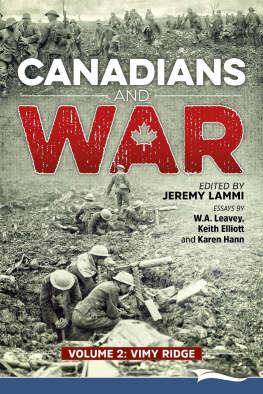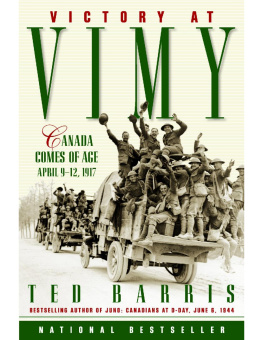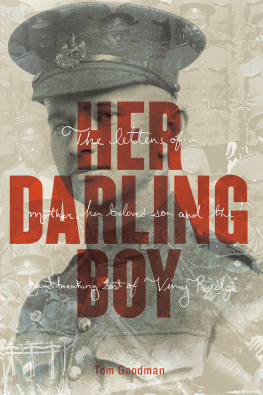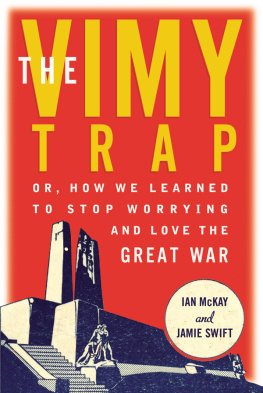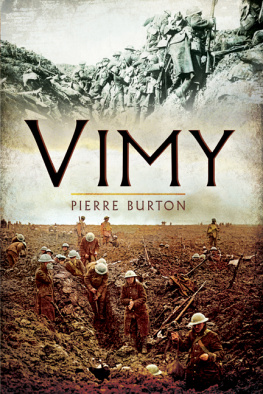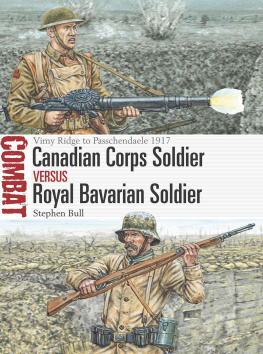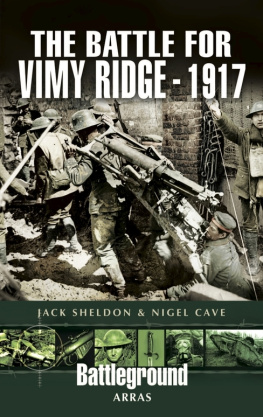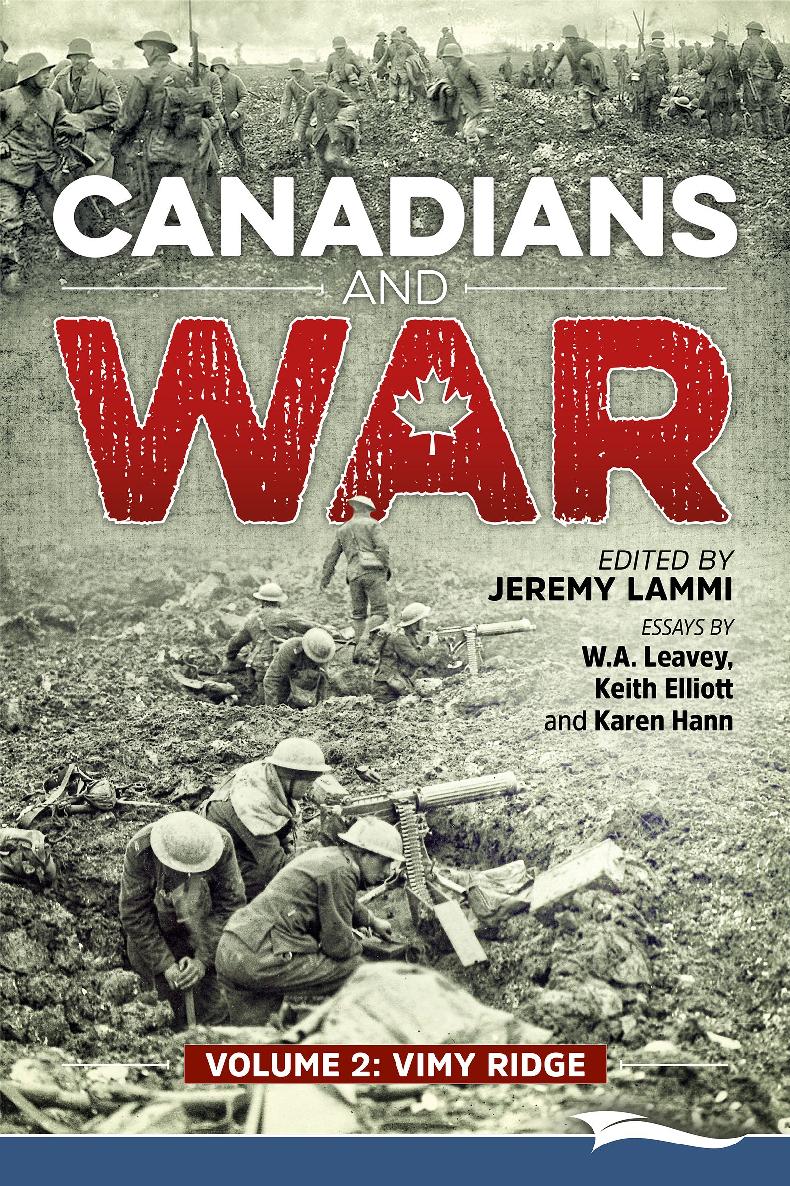Canadians and War
Volume 2: Vimy Ridge
Edited by Jeremy Lammi
Introduction by Jeremy Lammi
Essays by
W. A. Leavey
Keith Elliott
Karen Hann
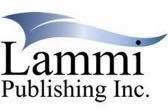
Published by Lammi Publishing, Inc. Headquartered in Coaldale, Alberta, Canada.
http://lammipublishing.ca
How did the Canadian Corps Achieve the Magnificent Victory at Vimy Ridge when Other Allied Armies Failed? W.A. Leavey, 2017. All rights reserved.
Vimy Ridge: Sons and Brothers Keith Elliott, 2017. All rights reserved.
A Dominion Comes of Age: The Battle of Vimy Ridge Karen Hann. All rights reserved.
Cover Image Credits
Canada. Dept. of National Defence/Library and Archives Canada/PA-001017
W.I. Castle / Canada. Dept. of National Defence / Library and Archives Canada / PA-001101
Vimy Ridge map produced by and Copyright 2017 Paul Hewitt, Battlefield Design. All rights reserved. www.battlefield-design.co.uk
Text and content editing by Karen Hann.
Cover design by Paul Hewitt Battlefield Design, UK.
Ebook formatting by www.ebooklaunch.com
Table of Contents
Lieutenant Colonel W.A. (Bill) Leavey, MA, CD (Retired)
Lieutenant-Colonel (Retired) W.A. (Bill) Leavey served in the Canadian Army Infantry from 1967 to 2008. The field units he served in include the Black Watch, Royal Highland Regiment of Canada (RHC), the Royal Canadian Regiment (RCR), the Canadian Airborne Regiment (CAR), and the Princess of Wales Own Regiment (PWOR). From 1994 to 1998 he was seconded with Veterans Affairs Canada as military liaison officer for the Canada Remembers Program, a commemoration group celebrating battle and campaign anniversaries for all of Canadas major wartime events. LCol Leavey holds a Masters degree in English from the Royal Military College. He has written two books of anecdotes for the RHC and RCR, entitled War Stories, Anecdotes and Lies. LCol Leavey has also published numerous stories, articles, and essays on military humour and humour in general in local and national magazines and newspapers. He lives in Kingston, Ontario with his wife Maureen, a 35-year veteran herself, and their Labradoodle Finnegan.
Keith Elliott
Keith Elliott is a stonecutter and artist living in Wallace, Nova Scotia. His blog can be found at www.ramblingriverside.com
Karen Hann
Karen Hann is a freelance writer and editor living in Lethbridge, Alberta. She received her Bachelor of Arts (English) degree at the University of Lethbridge and her Master of Arts (English; Creative Writing) degree at the University of New Brunswick, Fredericton.
by
Jeremy Lammi
The event that would come to be known as the Battle of Vimy Ridge took place April 9-12, 1917. Ninety-nine years later, I visited that site as part of a guided tour of the battlefields of northwest Europe (both World Wars). As a lifelong student of military history and a proud Canadian, making such a journey was absolutely extraordinary for me. Ive spent twenty-some years reading about those places. Some books (such as Pierre Bertons work), bring the experience of the battlefield to very vivid life. There are films, too, that re-create the horrors of war to such an authentic degree that people experience trauma just from watching them.
However, none of us born since those wars can truly comprehend what our brave fathers, grandfathers, and uncles bore as they crawled through those muddy trenches. We will never feel that barbed wire slicing into the flesh of bodies so young that they should have been running around a high school football field. Our ears will never hear that incomprehensible thunder of artillery and screams. Our noses will never experience that combined stench of blood, gunpowder, smoke, rot, and raw fear. Our eyes will never see that short, inevitable pathway to our own deaths amidst a hail of artillery fire in a field of barbed wire. We will never forge forward, knowing that we are about to watch our friends die in agony and be helpless to lift a finger to help. We know we can put the book down or walk out of the theatre. Many of these brave men charged forward into the maelstrom knowing that they were charging into the last few minutes of their lives.
The biggest reason for Lammi Publishings existence is to honour those men, and every man and woman who has donned the uniform in protection of others. As a scholar and a publisher, I honour them by studying their stories and facilitating a way for those stories to be shared beyond the classroom. As a human being, part of how I personally needed to honour them was to walk in the places theyd walked (albeit under far safer circumstances). That need brought me to the Vimy Ridge on May 1, 2016 with a tour group and my dad.
The Canadian National Vimy Memorial is located on the site of the battle itself in France, eight kilometres north of Arras. The land has been gifted to Canada, though French law still applies there. The land was deeded through the Imperial War Graves Commission (now called the Commonwealth War Graves Commission to the Government of Canada to commemorate the battle and honour those who made the ultimate sacrifice. Today, it stands as one of the few places in the world where authentic First World War trench lines are on display for the general public. Since much of the 100 hectares has not been reclaimed (and still may contain unexploded ordinance), visitors must remain confined to certain areas. Sheep mow the lawn, a beautiful reminder that life forever persists, even after so much death. As World War 1 archaeology gains ground as a discipline, the scholarly importance of the site will only increase.
We approached the area by bus. Coming in from the road, all we could see was trees, and we gained no real impression of the scope of the hill or the ridge. The first impression that we received at the site, besides the construction (which has been completed as of press time) was the trees from Canada that the Canadian government had planted there. You essentially walk through this beautiful corridor of branches and leaves through the trench lines. Some of those trenches have been deliberately preserved as part of the memorial site. Some of the original tunnels also remain, their chalk walls having been reinforced over the years to ensure safety. At the top of Hill 145 is the magnificent, world-famous monument rising up out of the earth.
The trees partially camouflage the contours of the ridge itself. There is one safe pathway up the hill to the memorial. Its a calm, paved, civilized bit of land, with no real indicators of the crater-marked slough of barbed wire, mud, and carnage that it was a century ago.
Though Ive known some of the scope of the monument for years, (made of 15,000 tonnes of steel and concrete, and 6,000 tonnes of Seget limestone), its a different thing to see it in person. It is, for lack of a better word, a monumental piece of architecture. The two pylons, each stretching 30 metres into the air, loom starkly over the landscape. One has a Canadian maple leaf, the other a French fleur-de-lis. The two nations, these pylons say, stand united and mourn together. Dad and I examined the various carvings of human figures, including the famous Mother Canada, a mater dolorosa -like figure who represents the nation mourning her dead. Like her more famous ancestresses, including Michaelangelos Pieta, she gazes to the east, to the dawn, in hopes of the new day bringing something better. Altogether, there are twenty carvings of human figures on the monument. They symbolize such things as a desire to lie down weapons and embrace peace and Canadas compassion for the oppressed. Even today, those symbols represent the values of our country. We spent a long time looking at the names of the 11,285 Canadian soldiers killed in France without any known grave that are carved along the exterior wall of the monument. I remember thinking of those eleven thousand families who lost their fathers, husbands, and sons, and I hoped that the fact that those names will remain forever on this magnificent monument did provide some comfort for those people.

